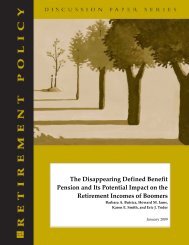View the entire report as a PDF - Tax Policy Center
View the entire report as a PDF - Tax Policy Center
View the entire report as a PDF - Tax Policy Center
You also want an ePaper? Increase the reach of your titles
YUMPU automatically turns print PDFs into web optimized ePapers that Google loves.
<strong>Tax</strong> & Social <strong>Policy</strong><br />
<strong>Tax</strong>ation and <strong>the</strong> Family<br />
In 2010, TPC provided estimates to policymakers, published several studies, hosted events,<br />
and participated in working groups concerned with family and children issues.<br />
One key concern is <strong>the</strong> complexity that <strong>the</strong> tax code imposes on low-income families,<br />
particularly those with children. Senior research <strong>as</strong>sociate Elaine Maag pursued several studies<br />
documenting that complexity and exploring ways to reduce it. In a paper published in <strong>the</strong><br />
National <strong>Tax</strong> Journal, for example, she summarized <strong>the</strong> major tax provisions affecting lowincome<br />
families and children, discussed how <strong>the</strong>y overlapped and created complexity, and<br />
examined ways to design a simpler, more effective child credit. In a related paper, she used<br />
TPC’s tax model to examine how to streng<strong>the</strong>n work and child credits by simplifying <strong>the</strong>m and<br />
clearly distinguishing a single work credit<br />
and a single child credit. She and a coauthor<br />
documented that many young childless<br />
men work at low incomes but receive<br />
very little <strong>as</strong>sistance. Distinguishing child<br />
and work credits could benefit <strong>the</strong>m.<br />
In a study for <strong>the</strong> College Board,<br />
Kim Rueben and Elaine Maag analyzed<br />
<strong>the</strong> possible use of information <strong>report</strong>ed<br />
on federal income tax returns in place of<br />
data collected on traditional financial aid<br />
forms to determine eligibility for student<br />
loans. They found that using data from<br />
tax returns could simplify <strong>the</strong> financial<br />
aid process for many families. Maag also<br />
Elaine Maag studies social <strong>as</strong>sistance in <strong>the</strong> tax system, advised <strong>the</strong> president’s tax commission<br />
particularly for low- and middle-income families. on ways to reform education tax benefits.<br />
Retirement Savings<br />
The <strong>Tax</strong> <strong>Policy</strong> <strong>Center</strong> fur<strong>the</strong>red its analysis of retirement savings <strong>as</strong> <strong>the</strong> nation’s demographics<br />
continued to shift toward an aging population. In The Shrinking <strong>Tax</strong> Preference for Pension<br />
Savings: An Analysis of Income <strong>Tax</strong> Changes, 1985–2007, Eric Toder and Gary Burt<br />
12





